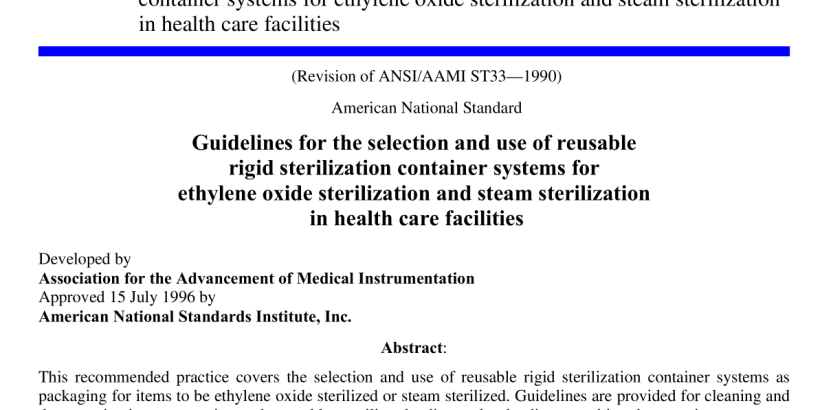ANSI AAMI ST33-1996 pdf download
ANSI AAMI ST33-1996 pdf download.Guidelines for the selection and use of reusable rigid sterilization container systems for ethylene oxide sterilization and steam sterilization in health care facilities
2.4 chemical indicator: Sterilization process monitoring device designed to respond with a characteristic chemical or physical change to one or more of the physical conditions within the sterilizing chamber. NOTE—Chemical indicators are intended to detect potential sterilization failures that can result from incorrect packaging, incorrect loading of the sterilizer, or malfunctions of the sterilizer. The “pass” response of a chemical indicator does not prove that the item accompanied by the indicator is sterile.
2.5 container, rigid sterilization: Packaging system designed to contain items for sterilization, storage, transportation, aseptic presentation of contents, and return of contaminated items to the decontamination area. NOTE—The system generally consists of a bottom or base with carrying handles and a lid that is secured to the base by means of a latching mechanism. A basket or tray to hold instruments or other items to be sterilized is placed inside. A filter or valve system is incorporated into the lid and/or base to provide for air evacuation and sterilant penetration during the sterilization cycle and to act as a barrier to microorganisms during storage.
2.6 contaminated: State of having been actually or potentially in contact with microorganisms. NOTE—As used in health care, the term generally refers to microorganisms that are capable of producing disease or infection.
2.7 cycle time: Total elapsed time of a sterilization cycle from the time the sterilizer door is closed and the cycle is activated until the time the cycle is completed and the door is opened. NOTE—Cycle time can include come-up or heat-up time, exposure time, come-down time, and cooling or drying time. For appropriate equipment, cycle time also can include prehumidification time, pre- and post-vacuum time, and aeration time.
2.8 decontamination: According to the Occupational Safety and Health Administration (OSHA), “the use of physical or chemical means to remove, inactivate, or destroy bloodborne pathogens on a surface or item to the point where they are no longer capable of transmitting infectious particles and the surface or item is rendered safe for handling, use, or disposal” [29 CFR 1910.1030]. NOTE—The term generally is used in health care facilities with reference to all pathogenic organisms, not just those transmitted by blood.
2.9 density: Mass per unit of volume.
2.10 filter: Device secured to the rigid container lid and/or bottom that serves to allow passage of air and sterilants yet provides a microbial barrier. NOTE—The filter media may be reusable, disposable, or permanently affixed to the container.
3.2 Transfer of contaminated items to the decontamination area
If the manufacturer’s written instructions permit, closed sterilization container systems (with solid bottoms or with filters in place, if applicable) can be used for containment and transport of contaminated instruments and medical devices to a decontamination area, where cleaning procedures can best be performed. Contaminated items should be handled as little as possible. Gloves should be worn when placing the contaminated items into the container. Care should be taken to avoid touching the outer surfaces of the container with gloved, soiled hands. Rationale: Some manufacturers instruct users not to use the same container system for transport of contaminated items as for sterilization, so it is important to consult the labeling. Contaminated items harbor microorganisms that can cause infection in susceptible individuals; gloves provide a barrier to direct contact with contaminated items. If the outer surfaces of the container are touched with gloved, soiled hands, then the entire container is considered contaminated.
